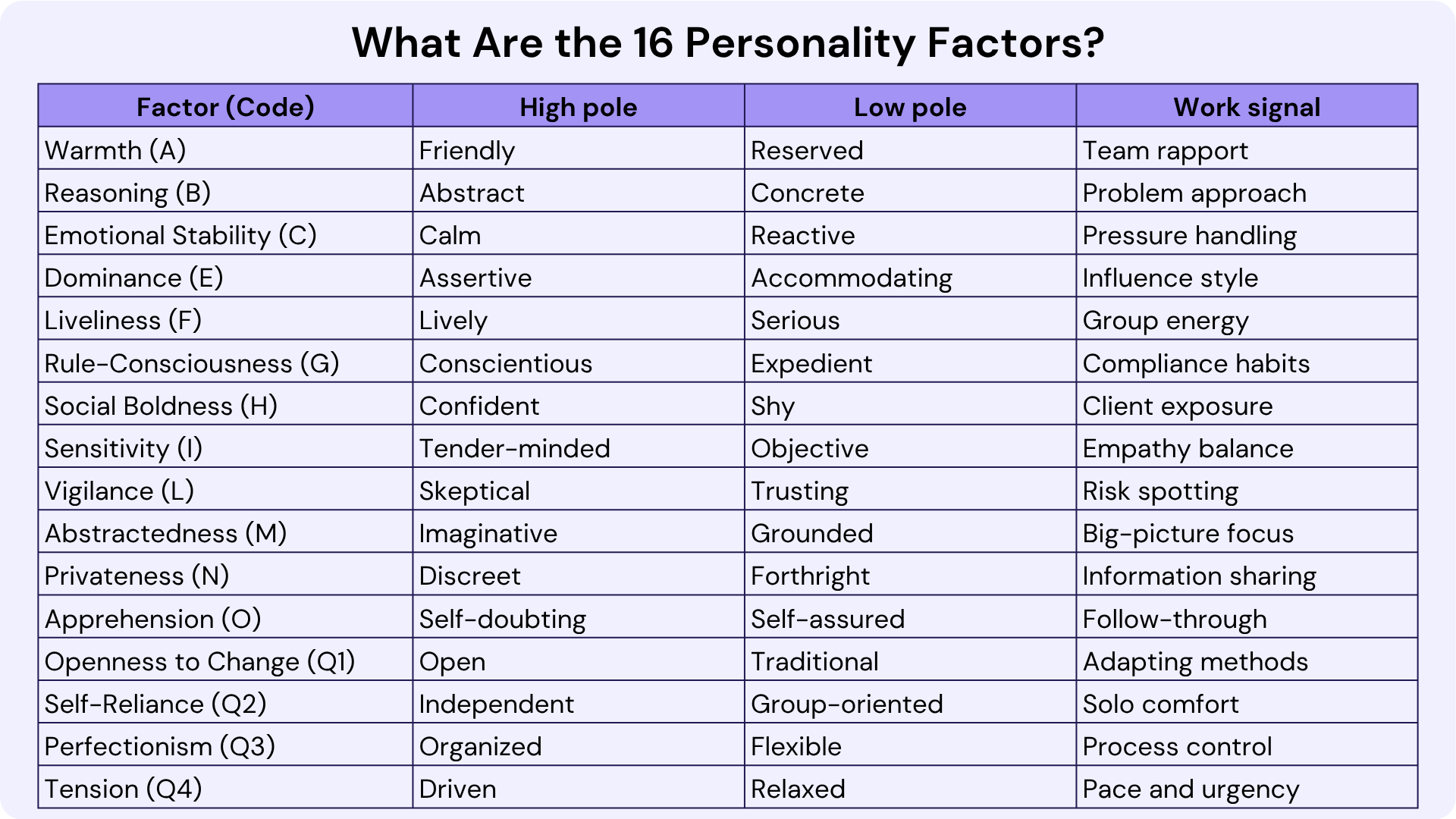
The 16PF questionnaire gives a structured reading of personality across sixteen traits. For HR leaders, it adds context around behavior, stress response, and collaboration. Used with job analysis and skills evidence, it reduces guesswork and improves fit without turning personality data into a gate.
Hiring carries risk. Resumes show outcomes, not habits. Interviews reveal style, but signals vary. The 16PF test helps interviewers ask sharper questions and plan support after hire. It should not replace work samples or role skills. It should inform decisions with clear boundaries and trained interpretation.
This guide explains what the tool measures, where it helps, and where it struggles. You will see concrete use cases, ethical guardrails, and a practical rollout. If you need assessments that pair skills and personality in one workflow, PMaps can help at pmapstest.com.
What Is the 16PF Personality Test?
The 16PF personality questionnaire was developed by Raymond Cattell using factor analysis. The inventory groups many observed behaviors into sixteen primary traits. Modern editions refine items and norms while keeping the same core model. Administration is standardized and requires adherence to usage rules.
A typical form contains about 185 items and takes roughly half an hour. Responses map to trait scores with percentile and sten scales. Reports summarize likely tendencies at work and under stress. Trained professionals connect those scores to job demands and interview prompts. That link to the job is essential.
The tool is not a clinical diagnosis and not a lie detector. It estimates trait patterns that persist over time. In hiring, the most honest use is simple: treat the 16PF questionnaire as one source of behavioral clues that supports interviews and onboarding, not as a verdict.
What Are the 16 Personality Factors?
These primary traits can roll up into broader global clusters in some reports. Those clusters aid summary, yet hiring decisions should still trace back to the primary traits and the job’s real demands.

Where the 16PF Helps in HR
When used thoughtfully, 16PF based assessments support everyday talent management. It sharpens interviews, informs training needs, and clarifies team dynamics. When tied to job demands and skills evidence, the profile reduces guesswork and prepares managers for onboarding and role transitions. Here’s how:
Selection support. When tied to a job profile, results guide structured interviews. You probe stress handling, planning, and collaboration with precision. For sales, you may focus on dominance and social boldness. For compliance, you may focus on rule-consciousness and vigilance.
Leadership development. The profile helps frame coaching plans. Leaders can improve communication, delegation, and decision cadence. Managers gain a common language to discuss needs and trade-offs with their teams.
Team dynamics. Aggregated signals show where teams lean. You might notice high drive and low patience, or strong structure with limited openness to change. That insight informs staffing and change plans.
Career counseling and mobility. Employees receive feedback on strengths and friction points. HR can match projects with natural tendencies while still requiring skills growth. The 16PF cattell model supports these conversations when handled by trained staff.
Strengths of the 16PF
When teams need more than broad labels, the 16PF adds usable detail. Sixteen primary traits create clearer interview prompts, steadier panel alignment, and reports managers can act on—without reducing people to types or overrelying on gut feel.
- Granularity. Sixteen primary traits provide more texture than type labels.
- Standardization. Clear rules for administration and normed scoring keep results comparable.
- Breadth of use. Applicable across selection support, coaching, and team reviews.
- Interview alignment. Results translate into behavior-based questions that reduce guesswork.
Limits You Must Manage While Using 16PF
Even well-researched instruments have edges. The 16PF delivers value only when boundaries are clear—trained interpretation, thoughtful funnel placement, and sound data practices. Before rollout, weigh time, cost, and candidate trust so personality insights support decisions rather than drive them.
- Not a stand-alone filter. Do not use it as a pass/fail gate. Combine with work samples and structured behavioral event interviewing.
- Training required. Untrained reading invites overreach and error. Maintain certified interpretation.
- Time and cost. Completion time and practitioner hours add to the process.
- Candidate trust. Early placement can cause drop-offs. Explain purpose and privacy clearly.
Taking the 16PF Questionnaire Online
Official 16PF questionnaire online delivery runs through licensed providers. They manage secure hosting, norms, and scoring. Unofficial “free” versions mimic format yet lack validated scoring. Use them for familiarity only, not for decisions or files.
If you administer at scale, set scheduling rules that respect bandwidth and accessibility. Provide a contact for support. Keep the experience short and clear. If your policy supports feedback, offer a brief summary with guidance to next steps.
Best Practices for Using the 16PF in Hiring
Turn personality data into useful decisions with a few guardrails. Anchor 16PF use to role needs, keep interpretation trained, and pair scores with skills evidence. These practices keep hiring fair, repeatable, and defensible without slowing teams.
- Pair results with a job analysis and skills evidence.
- Share evaluation criteria with candidates and panels.
- Keep interpretation with trained staff.
- Use behavior-based interview questions tied to traits.
- Provide a short feedback note when policy allows.
For a combined workflow, pair personality data with a role-specific test set. PMaps supports skills screens, coding assessment tools, and psychometrics in one place, with reporting suited for panels and audits. See examples at pmapstest.com.
Conclusion
The 16PF questionnaire adds structured, trait-level insight across sixteen dimensions. It works best when tied to the job, read by trained staff, and paired with skills evidence. Handle privacy with care, keep notes behavior-based, and review outcomes on a schedule.
Want a balanced workflow you can ship this quarter? See PMaps assessments at pmapstest.com. Get a live walkthrough tailored to your roles and levels. Call 8591320212 or write to assessment@pmaps.in to review sample reports, question banks, and scoring flows that pair skills and personality cleanly.




.png)




